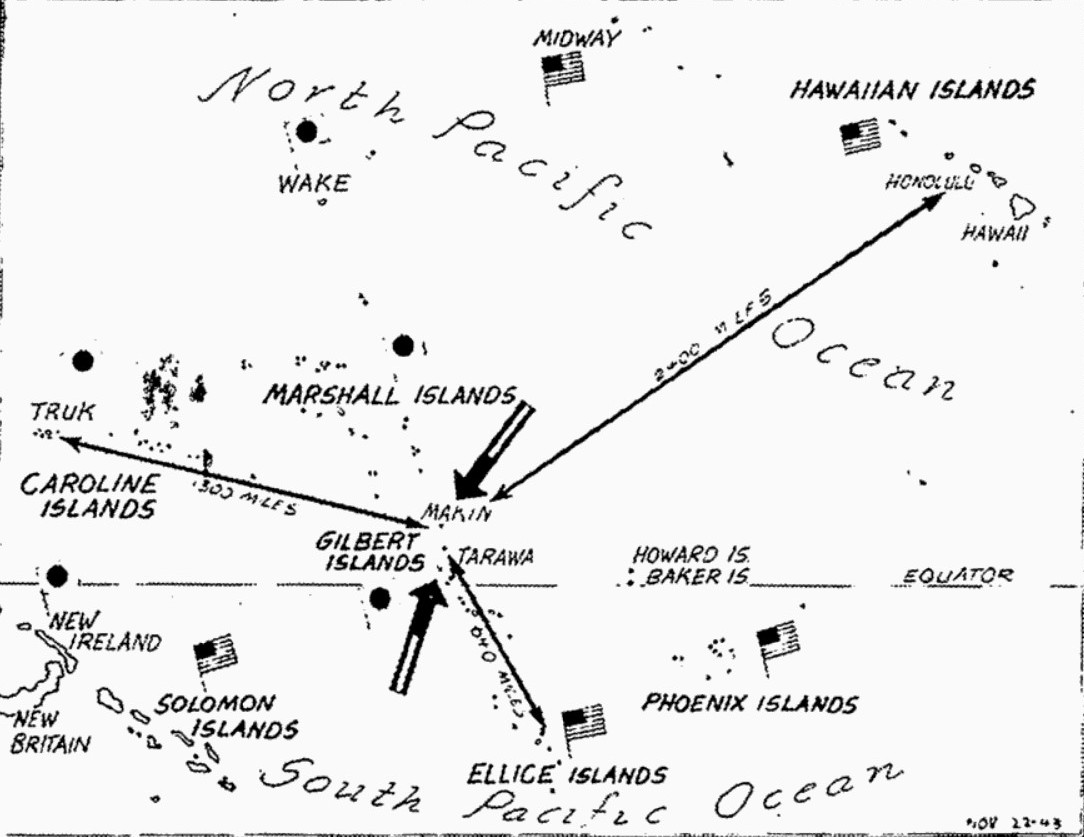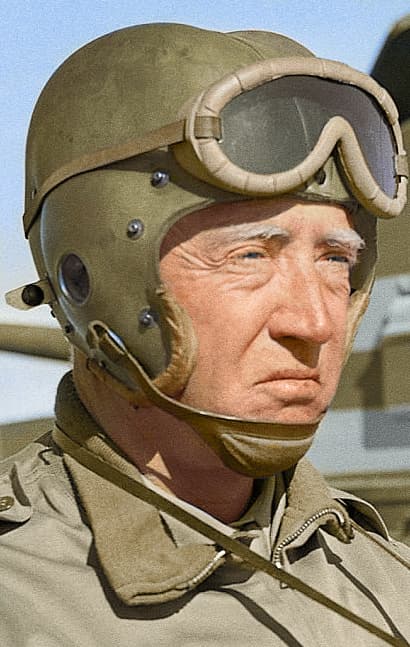The Pittsburgh Press (November 22, 1943)
YANKS STORM 2 JAP ISLANDS
Heavy fighting rages in Gilberts; warships, planes cover invasion
Marine, Army troops hit Makin and Tarawa before dawn
By William F. Tyree, United Press staff writer

New Pacific invasion by U.S. forces has penetrated the Jap belt of defenses in the Gilbert Islands. U.S. troops went ashore north of the equator on the Makin and Tarawa Atolls, shown by the heavy arrows.
Pearl Harbor, Hawaii –
U.S. invasion forces backed by a strong fleet and covered by a canopy of planes battled today to crush two Jap outposts in the Gilbert Islands in the first phase of a mid-Pacific offensive on the flank of the ocean road to Tokyo.
Hand-to-hand fighting with Jap defenders was believed raging on the narrow, sandy beachheads on Makin and Tarawa Atolls of the Gilberts, which lie astride the equator some 2,400 miles southwest of Honolulu.
A communiqué by Adm. Chester W. Nimitz’s headquarters announcing the landing made before dawn Saturday by battle-experienced Marines and soldiers said only that “moderate resistance” was met at Makin but reported “strong opposition” at Tarawa, major center on the coral island chain.
The Jap news agency Dōmei, in the Tokyo broadcast, said “heavy fighting” was in progress, adding that the attacking forces included aircraft carriers and battleships and that Makin and Tarawa were “repeatedly bombed and shelled” from Friday morning on.
Backed by strong fleet
Carrying U.S. land operations north of the equator in the Central Pacific for the first time since the start of the war, the forces went ashore while a fleet, described by the communiqué as “powerful,” protected their invasion. Six straight days of bombing had softened the enemy’s hold or neutralized adjacent bases.
While long-range strategy remained undisclosed, it was apparent that the attack had two main objectives:
-
A pincer on the strong Jap naval air base of Truk, in the Carolines 1,300 miles northwest, in cooperation with Gen. Douglas MacArthur’s forces moving up from the south.
-
A thrust to open the chain of island bases protecting Japan’s long Pacific lines, eliminating enemy strongholds on the flank of the main route across the Pacific toward Tokyo.
Coordination close
Close coordination of the offensive by naval forces with the Army was indicated by a conference between Adm. Nimitz and Lt. Gen. Robert C. Richardson Jr., Army commander in the Central Pacific, after the invasion was announced yesterday.
Army Liberators started the pre-invasion blasting of the Gilberts and the adjacent Marshall Islands – both north of the American-held Ellice Islands – a week ago last Saturday. In the last stages of the softening-up process, the fleet joined, sending planes to dump 90 tons of bombs on Nauru, phosphate island to the west.
Runways wrecked
After raids Friday, a front dispatch said that on Tarawa, site of an airstrip, the runways were reduced and barracks ruined. Only two planes, both wrecked, were sighted on the ground. The only sign of life was a few Japs running from machine-gun fire.
Marine veterans of the Solomons were believed part of the invasion force.
As the troops waded ashore, Liberators ranged over the Marshalls to knock out any Jap attempt to send harassing planes southward from bases there.
Send strong force
The communiqué’s report that units of “all types” were included in the U.S. battle fleet indicated battleships, carriers, cruisers and destroyers took part and presumably pumped shells into the tiny island to loosen the enemy’s entrenchments on the coconut-tree-lined beaches.
Adm. Nimitz inferred some time ago in a speech that strong resistance was expected, announcing the Japs would be “dug out” of their island strongholds. It was safe to assume a strong force capable of taking and holding the islands went in.
The communiqué said the troops “have established beachheads,” presumably in the face of enemy machine-gun fire from pillboxes and log fortresses.
It was believed the troops concentrated on Betio Island in the 22-mile-long series of Tarawa islets which surround a lagoon with a good anchorage. At the Makin Atoll, which includes Little Makin (only 2.75 miles long) and Butaritari (11 miles long), the latter island was thought to be the prime objective.
Found four wharves
Col. Evans Carlson’s Raiders, who swept the Makin group on Aug. 17, 1942, reported Butaritari, which is less than 1,000 yards wide its entire length, and four wharves, a two-lane asphalt road, a seaplane landing and supply dumps.
Because of the exposed sea approaches and beaches, landing probably necessitated braving enemy fire out in the open on such small islands.
It was considered possible the invasion would expand, soon if not concurrently with the Gilberts attack, into the Marshalls, which would have to be reduced to protect the holdings. Makin is less than 200 miles from the Marshalls.
Other islands to the south in the Gilberts would be neutralized by the conquest od Makin and Tarawa. They are in the northern section, just above the equator, in the string of 16 main atolls which stretch 400 miles from four degrees north to three degrees south of the equator. Their total land area is 166 square miles. The islands were seized by the Japs from the British early in 1942. They were formerly a Crown colony with a population of about 26,000, mostly natives. The Jap population was not known.
The islands have been hit intermittently by naval or air forces since they were taken.
Most of the islands have eight feet or less of beach and are coral rock with a scanty topsoil in which coconut groves are planted.
They formed the mid-Pacific outer line of the Jap outposts now crushed in the Aleutians to the north, running southward through Wake Island – where positions may be neutralized by this attack – through the Marshalls, the Gilberts, the Solomons, New Guinea and on into the Indies.

